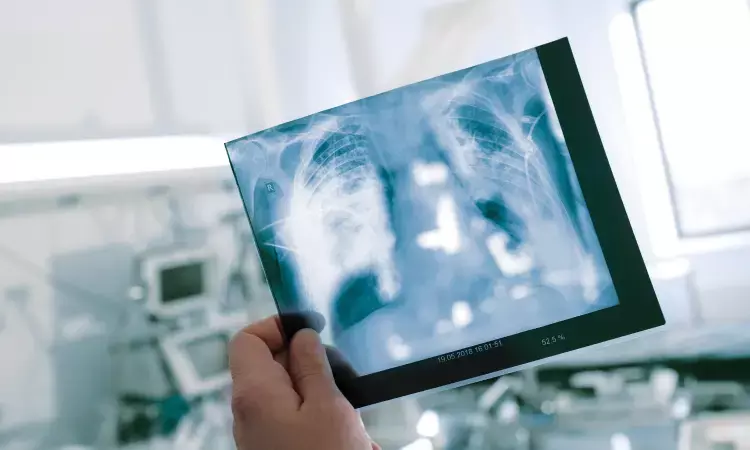- Home
- Medical news & Guidelines
- Anesthesiology
- Cardiology and CTVS
- Critical Care
- Dentistry
- Dermatology
- Diabetes and Endocrinology
- ENT
- Gastroenterology
- Medicine
- Nephrology
- Neurology
- Obstretics-Gynaecology
- Oncology
- Ophthalmology
- Orthopaedics
- Pediatrics-Neonatology
- Psychiatry
- Pulmonology
- Radiology
- Surgery
- Urology
- Laboratory Medicine
- Diet
- Nursing
- Paramedical
- Physiotherapy
- Health news
- Fact Check
- Bone Health Fact Check
- Brain Health Fact Check
- Cancer Related Fact Check
- Child Care Fact Check
- Dental and oral health fact check
- Diabetes and metabolic health fact check
- Diet and Nutrition Fact Check
- Eye and ENT Care Fact Check
- Fitness fact check
- Gut health fact check
- Heart health fact check
- Kidney health fact check
- Medical education fact check
- Men's health fact check
- Respiratory fact check
- Skin and hair care fact check
- Vaccine and Immunization fact check
- Women's health fact check
- AYUSH
- State News
- Andaman and Nicobar Islands
- Andhra Pradesh
- Arunachal Pradesh
- Assam
- Bihar
- Chandigarh
- Chattisgarh
- Dadra and Nagar Haveli
- Daman and Diu
- Delhi
- Goa
- Gujarat
- Haryana
- Himachal Pradesh
- Jammu & Kashmir
- Jharkhand
- Karnataka
- Kerala
- Ladakh
- Lakshadweep
- Madhya Pradesh
- Maharashtra
- Manipur
- Meghalaya
- Mizoram
- Nagaland
- Odisha
- Puducherry
- Punjab
- Rajasthan
- Sikkim
- Tamil Nadu
- Telangana
- Tripura
- Uttar Pradesh
- Uttrakhand
- West Bengal
- Medical Education
- Industry
2D shear wave elastography, excellent option to assess diaphragm and intercostal muscle stiffness in COPD

China: A recent study has concluded that 2D-Shear Wave Elastography (2D-SWE) is a valuable tool in COPD patients which facilitates the assessment of stiffness of the diaphragm and intercostal muscles. These are associated with lung function.
The findings of the study are published in BMC Pulmonary Medicine.
It is already known that there is an impaired respiratory function in COPD (Chronic obstructive pulmonary disease). This is caused by dysfunction of respiratory muscle. With COPD progression, lung function impairment develops, and there is a gradual increase in the DS (diaphragm stiffness) and IMS (intercostal muscle stiffness).
A study was conducted by a team of researchers led by Yongjian Chen from the Second Affiliated Hospital of Fujian Medical University, China, in which the researchers used 2D-SWE to measure DS and IMS. The team also determined the importance of 2D-SWE in COPD patients to evaluate respiratory function.
The researchers also answered the question,
"What is the correlation between the stiffness of respiratory muscle and lung function and the differences in stiffness in COPD patients with different severities?"
The essential study points and the result are:
• The study had 219 COPD patients and 20 healthy adults.
• 2D-SWE measured DS and IMS.
• The lung function was also assessed.
• DS and IMS had high consistency and repeatability with ICCs of 0.756 and 0.876, respectively. The average differences between physicians were recorded as 0.10 ± 1.61 and 0.07 ± 1.65.
• There was an increase in DS and IMS with severity in COPD patients, F1 = 224.50, F2 = 84.63; the P value was < 0.001.
• The following correlations in COPD patients with FEV1/ FVC predicted FEV1% value, RV, TLC, RV/TLC, FRC and IC of DS was more potent than that of IMS.
• In DS, r1, r2, r3, r4, r5, r6 and r7 were -0.81, -0.63, 0.65, 0.54, 0.60, 0.72 and -0.41 with P < 0.001.
• In IMS, r1, r2, r3, r4, r5, r6 and r7 were -0.76, -0.57, 0.57, 0.47, 0.48, 0.60 and -0.33 with a P value of < 0.001.
The researchers finally concluded that,
The role of 2D-SWE is the potential to evaluate DS and IMS. There is a correlation specifically between the stiffness of respiratory muscles and lung function.
There is a gradual increase in DS and IMS with worsening COPD severity and lung function impairment (progression).
Dr Jingyun Li from the Quanzhou Medical College summarised that 2D-SWE assess the changes in the elastic modulus of the respiratory muscles of patients with COPD severities. This technology can quantitatively evaluate the function of respiratory muscles when combined with the two-dimensional ultrasound examination (diaphragm movement), contraction amplitude and other items.
Further reading:
Chen, Y. et al. Two-dimensional shear wave elastography: a new tool for evaluating respiratory muscle stiffness in chronic obstructive pulmonary disease patients. BMC Pulm Med 22, 441 (2022). https://doi.org/10.1186/s12890-022-02231-4
BDS, MDS in Periodontics and Implantology
Dr. Aditi Yadav is a BDS, MDS in Periodontics and Implantology. She has a clinical experience of 5 years as a laser dental surgeon. She also has a Diploma in clinical research and pharmacovigilance and is a Certified data scientist. She is currently working as a content developer in e-health services. Dr. Yadav has a keen interest in Medical Journalism and is actively involved in Medical Research writing.
Dr Kamal Kant Kohli-MBBS, DTCD- a chest specialist with more than 30 years of practice and a flair for writing clinical articles, Dr Kamal Kant Kohli joined Medical Dialogues as a Chief Editor of Medical News. Besides writing articles, as an editor, he proofreads and verifies all the medical content published on Medical Dialogues including those coming from journals, studies,medical conferences,guidelines etc. Email: drkohli@medicaldialogues.in. Contact no. 011-43720751


